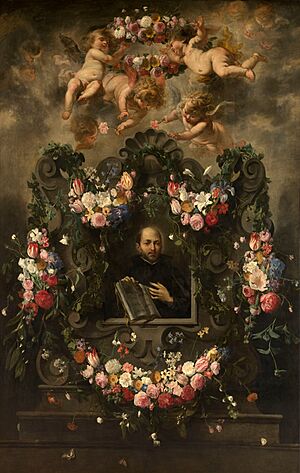Daniel Seghers facts for kids
Daniël Seghers (born December 3, 1590 – died November 2, 1661) was a Flemish Jesuit brother and a talented painter. He was famous for his beautiful flower still life paintings. He was especially known for creating a special type of painting called "flower garland paintings." Many rich people loved his art, and he had many students and people who copied his style.
Contents
The Life of Daniël Seghers
Daniël Seghers was born in Antwerp, which is now in Belgium. When he was about 11 years old, after his father died and his mother became a Protestant, he moved with his mother to the Dutch Republic, probably to a city called Utrecht. This is where he might have started learning to paint.
By 1611, young Daniël returned to Antwerp. There, he joined the Guild of Saint Luke, which was a group for artists. He became a student of a famous painter named Jan Brueghel the Elder.
In 1614, Seghers decided to become a Catholic again. He joined the Jesuit order in Mechelen. The Jesuits are a religious group within the Catholic Church. In 1625, he made his final promises to the Jesuit order. Some people say he became a priest, while others say he remained a "lay brother," which means he was a member of the order but not a priest.
After 1625, Seghers went to Rome, Italy, for two years. In Rome, he worked with other important painters. He even worked with Nicolas Poussin on some religious paintings. For a powerful church leader named Cardinal Ludovisi, Seghers painted a garland of flowers around a special oval shape. Inside this shape, another Italian painter, Domenichino, painted little angels. This painting is called Double wreath surrounding a medaillion with the triumph of love.
Seghers came back to Antwerp in 1627 and continued painting there for the rest of his life. Many important people visited his studio in Antwerp. These included royal figures like the Cardinal-Infante Ferdinand of Austria, Archduke Leopold Wilhelm of Austria, Christina, Queen of Sweden, and Charles II, King of England. He even painted a special flower design for King Charles II. Other artists, like the famous Rubens, also admired his work.
Some of his students included Jan Philip van Thielen, Ottmar Elliger, Ignace Raeth, and probably Andries Bosman.
Daniël Seghers' Artworks
What Seghers Painted
Daniël Seghers focused only on painting flowers. He mostly painted "cartouches" and "flower garlands," as well as simple flower paintings. He painted a lot! We know of 239 paintings that are believed to be his. It's hard to know exactly when he painted them because he only dated his works between 1635 and 1651.
At first, his flower garlands looked very even. Later, he started arranging flowers in three or four groups, making them look more natural. His early paintings show the clear influence of his teacher, Jan Brueghel the Elder. After 1630, Seghers tried to make his flowers look more alive and natural. In his later works, the flowers seem to glow against a dark background, almost like sculptures.
Like his teacher Brueghel, Seghers painted flowers and plants that grew in his home country, especially garden flowers. He didn't worry about whether the flowers would bloom at the same time in real life. He especially liked painting local roses and tulips that were just about to open. He was very skilled at showing tiny details in his flowers and plants, almost like a miniature painter.
Many of Seghers' paintings were done with oil paint on copper. Copper was often used for smaller, detailed paintings called "cabinet paintings."
Garland Paintings Explained
Most of Seghers' work belongs to a special Flemish art style called "garland paintings." This style of still life painting was created in Antwerp by Seghers' teacher, Jan Brueghel the Elder, around the early 1600s. Other artists like Hendrick van Balen and Peter Paul Rubens also helped develop this style.
Garland paintings usually show a beautiful garland of flowers wrapped around a religious picture, a portrait, or another religious symbol. Later, artists also used portraits or scenes from myths in the center. Seghers added his own touch to this style. Instead of just flowers, he often used a stone cartouche (a decorative frame) for the center part of the painting. He also painted some garland paintings of the Pietà (a scene showing Mary holding Jesus after his crucifixion). In these, he used thistles, thorns, and other harmful plants instead of pretty flowers to show Christ's suffering.
Garland paintings were often a team effort. Seghers usually only painted the flowers. Another artist would then paint the main subject in the middle. This teamwork was very common in Flemish painting during the 1600s.
While many artists who worked with Seghers are unknown, he often teamed up with famous figure painters from Antwerp. We don't always know for sure who painted the central part of his works, even though Seghers kept a list of his paintings and who he painted them for. He described each painting, his helper, and how many paintings he made. Because his list isn't complete, we don't always know for sure who his collaborators were.
We do know he often worked with Cornelis Schut, Erasmus Quellinus II, Abraham van Diepenbeek, Simon de Vos, Jan van den Hoecke, Gonzales Coques, and Rubens. Thomas Willeboirts Bosschaert is also mentioned as a collaborator. It's possible Seghers even worked with Rubens on a garland painting for the Saint Carolus Borromeus church in Antwerp. When he was in Rome, he also worked with Poussin and Domenichino.
Some of these garland paintings were very large. For example, the painting Saint Ignatius in a cartouche with flowers and cherubs is about 190 by 299 centimeters (about 6 by 9.8 feet)! In this painting, Cornelis Schut painted the cartouche, and angels were added by Jan van Balen.
Images for kids
See also
 In Spanish: Daniel Seghers para niños
In Spanish: Daniel Seghers para niños







